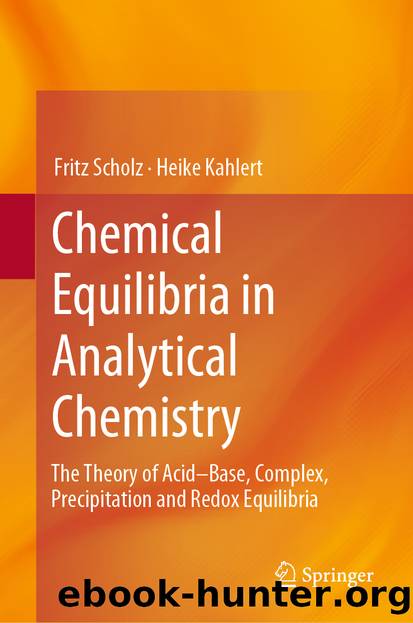Chemical Equilibria in Analytical Chemistry by Fritz Scholz & Heike Kahlert

Author:Fritz Scholz & Heike Kahlert
Language: eng
Format: epub
ISBN: 9783030171803
Publisher: Springer International Publishing
The formation of mixed crystals (solid solutions) is not only an issue in analytical chemistry but plays an important role in many technologies too, including roles in the metallurgy and semiconductor industries. Mixed crystals can be made up of ions as well as of molecules; inorganic and organic constituents are possible. For example, mixed crystals of urea and thiourea can exist. In analytical chemistry, mixed crystals consisting of as the major constituent and small concentrations of in the cation sublattice are used as membranes for fluoride sensitive electrodes, because charge neutrality affords that the ions create vacations in the fluoride sublattice, and these vacations result in a slight increase of ionic conductivity of the membrane—a prerequisite for the application of the membrane in potentiometric measurements.
Oxygen sensors (lambda sensors), used for the control of oxygen content in exhaust gases of combustion engines in automobiles, have a solid electrolyte based on with ions in a cation sublattice. Also here, charge neutrality affords that the presence of ions creates vacancies in the anion () sublattice, which guarantees a sufficient ionic conductivity at temperatures of 550–700 °C. The solid electrolyte separates two noble metal electrodes, one in the exhaust gas and one in the atmosphere, and the voltage between the two electrodes is a measure of the oxygen partial pressures in both gases.
Adsorption of component B on the surface of A
Normally, precipitates possess high surface areas because of their small particles; sometimes these surface areas can be very large. The surfaces of precipitates, especially of metal oxides, hydroxides, and oxide hydrates, are prone to bind metal ions by surface complexation (Chap. 4). Such adsorptive binding is another reason for coprecipitation. It is controlled by thermodynamics and characterized by sorption equilibrium constants.
Occlusion of solution droplets containing component B in the precipitate of A
The inclusion of solution droplets in a precipitate is called occlusion. This is more or less a random phenomenon, not controlled by thermodynamics (although the wettability, a thermodynamic property, of the surface by the solution may have effects). Occlusion can be minimized by choosing the right precipitation conditions, especially the right precipitation rate: fast precipitation favors occlusion and slow precipitation can minimize it. When a precipitation agent, e.g., a sodium hydroxide solution, is dropped into an iron(III) chloride solution, the locally very high hydroxide concentration may easily lead to the occlusion of the solution (sodium and chloride ions) and the precipitate may, even after washing, still contain sodium and chloride ions. A much better approach is so-called homogeneous precipitation: adding hexamethylenetetramine (also called methenamine or urotropin) to the cold solution does not lead to any precipitate; however, when the solution is slowly heated, hexamethylenetetramine hydrolyzes and forms ammonia and formaldehyde, and the ammonia reacts with the water to provide ammonium ions and hydroxide ions. The latter precipitate iron(III) oxide hydrate. This precipitation takes place from an homogeneous solution, and so occlusion is minimal.
Download
This site does not store any files on its server. We only index and link to content provided by other sites. Please contact the content providers to delete copyright contents if any and email us, we'll remove relevant links or contents immediately.
| Anatomy | Animals |
| Bacteriology | Biochemistry |
| Bioelectricity | Bioinformatics |
| Biology | Biophysics |
| Biotechnology | Botany |
| Ecology | Genetics |
| Paleontology | Plants |
| Taxonomic Classification | Zoology |
Sapiens: A Brief History of Humankind by Yuval Noah Harari(14256)
The Tidewater Tales by John Barth(12609)
Mastermind: How to Think Like Sherlock Holmes by Maria Konnikova(7231)
Do No Harm Stories of Life, Death and Brain Surgery by Henry Marsh(6891)
The Thirst by Nesbo Jo(6832)
Why We Sleep: Unlocking the Power of Sleep and Dreams by Matthew Walker(6620)
Life 3.0: Being Human in the Age of Artificial Intelligence by Tegmark Max(5478)
Sapiens by Yuval Noah Harari(5295)
The Longevity Diet by Valter Longo(5021)
The Body: A Guide for Occupants by Bill Bryson(4976)
The Rules Do Not Apply by Ariel Levy(4866)
The Immortal Life of Henrietta Lacks by Rebecca Skloot(4528)
Animal Frequency by Melissa Alvarez(4399)
Why We Sleep by Matthew Walker(4362)
The Hacking of the American Mind by Robert H. Lustig(4319)
Yoga Anatomy by Kaminoff Leslie(4309)
All Creatures Great and Small by James Herriot(4233)
Double Down (Diary of a Wimpy Kid Book 11) by Jeff Kinney(4208)
Embedded Programming with Modern C++ Cookbook by Igor Viarheichyk(4105)
